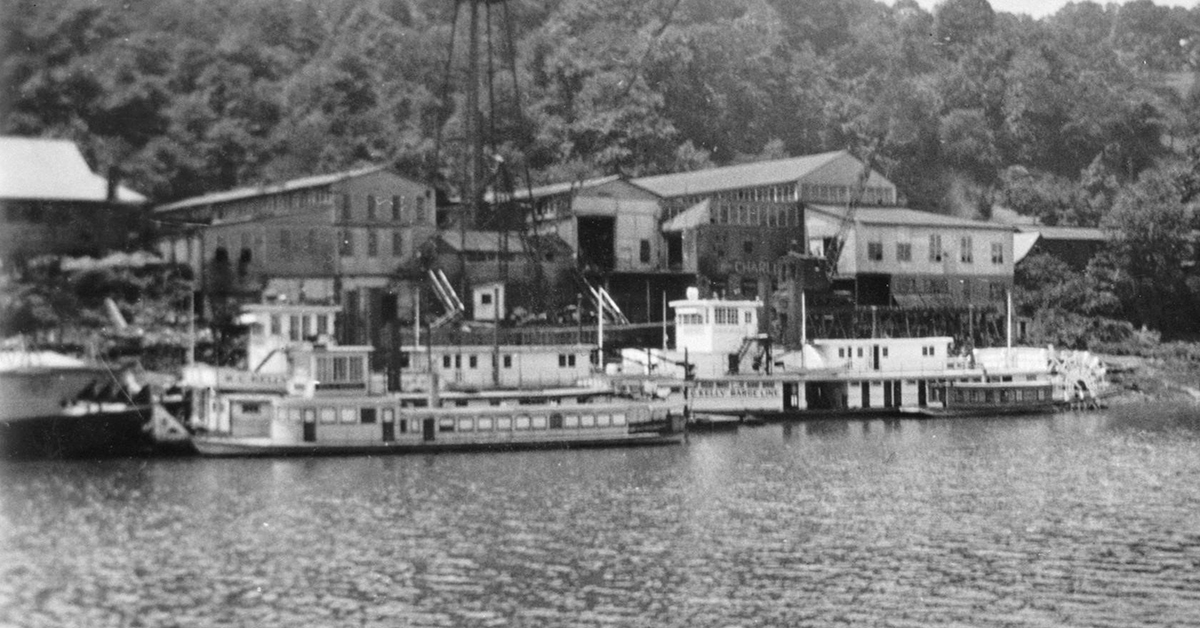As often mentioned in this column, the Charles Ward Engineering Works, Charleston, W.Va., was an early proponent of both tunnel stern prop-driven towboats as well as boats powered by diesel engines. W.C. Kelly, of the Kelly Axe & Tool Works, also of Charleston, took an interest in river transportation in the early 1920s and turned to Ward to build boats and barges for his new barge line. The W.C. Kelly Barge Line began with the diesel sternwheel W.C. Kelly in 1923, which was joined in 1925 by the first twin-screw diesel line haul towboat, the Geo. T. Price.
In April 1927, these two were joined by a near duplicate of the Price named W.A. Shepard after an official with Kelly Axe. Like the Price, it had 720 hp. from two Fairbanks-Morse direct-reversing diesels, and the steel hull was 126 feet by 26 feet. The lower cabin and elevated pilothouse above that were of steel, with a wooden cabin on the second deck behind the twin smokestacks. While the Price had a flat front compared to the pilothouse on the Shepard, the front side corners of the structure were angled. Both a traditional pilot wheel and steering levers were provided to control the rudders.
In July of 1927, Ward delivered another boat to Kelly. This one was a slightly larger boat that had twin sternwheels rather than props. It was powered by the same model F-M engines delivering 720 hp. and was designed to be the latest in diesel sternwheel propulsion. In November 1927, W.C. Kelly joined with Andew and Patrick Calhoun to form American Barge Line (ABL). In December of that year, a contest of sorts was staged on the Monongahela River between the Bruce and the twin screw W.A. Shepard. The boats were equal in horsepower, and each had six loads of coal. In nearly every aspect, the prop-driven Shepard outperformed the sternwheel Bruce. The one exception was in flanking ability, and subsequent changes to the rudder configuration on the Shepard and her near sister Geo. T. Price corrected this.
ABL secured a contract to tow cotton down the Lower Mississippi and, due to the cargo being stacked high on the barges, another pilothouse was placed atop the original on the W.A. Shepard and the Geo. T. Price to give them better visibility over the tall cotton. In 1938, the original F-M engines were replaced by a pair of National Superior eight-cylinder, direct-drive diesels totaling 1,350 hp. at 300 rpm. Soon after the repowering, the boat was sold to the fledgling Central Barge Company, a new concern towing on the Illinois and Upper Mississippi rivers with A.C. Ingersoll as manager of operations.

In the August 20, 1938, issue of The Waterways Journal was a news story about the new Central Barge Company inviting bids to build two steam sternwheel towboats of 1,500 hp. and a fleet of 32 barges. Central had the Alexander Mackenzie, built by Marietta Manufacturing Company at Point Pleasant, W.Va., but an announcement was made in the December 17, 1938 WJ that Central had “purchased the twin-screw diesel towboat W.A. Shepard from American Barge Line,” and the second steam sternwheel towboat for Central was never built.
Capt. Norman Hillman makes much mention of the Shepard in his book “One Man and the Mighty Mississippi.” He went to work for Central soon after the company was formed and was on the W.A. Shepard as pilot with Capt. L.J. Sullivan as master or roof captain and Capt. Don Gordon as the other pilot. Soon after, this the company did away with the roof captain position and had only master-pilot and pilot aboard. While he did work aboard other company vessels, he was aboard the boat in 1941when it was renamed Wheelock Whitney and personally painted the new name on the name boards.
In 1952, Central Barge was merged into the Mississippi Valley Barge Line Company. The Whitney continued in the Valley Line and had the radio call sign WB 4449. It was sold in 1960 to Capt. John B. Ritchie, Cape Girardeau, Mo., who renamed it John Paul. The List of U.S. Merchant Vessels (LIST) would show the owner as “Perryville Barge Lines, Inc. (Miss.)” with the home port shown as Baton Rouge, La. Later listings in the Inland River Record gave the vessel width as 32.6 feet, indicating that at some point sponsons may have been added to the sides of the hull, as had been done to the sister vessel Geo. T. Price.
A note in the Upper Mississippi news column of the November 5, 1960, issue of the WJ said that the John Paul had been upbound with four loads of coal from Parsons, Tenn., to St. Paul on October 31 when it was swamped by rough waves from a 40-mph wind near Nauvoo, Ill., on the Upper Miss. The crew escaped to the barges as the boat sank about 1,000 feet from the Illinois shore at Mile 378.4 with only the pilothouse showing above water.
After having helped give life to W.C. Kelly Barge Line, American Barge Line (ACBL today) and Central Barge Company, the John Paul was listed under Vessels Lost in the LIST for 1963. It was never raised and, today, during the navigation season, a buoy is placed at the site of the sinking noted on charts as “Sunken M/V John Paul Lighted Buoy.”
Featured image caption: The W.A. Shepard (inboard) with the Duncan Bruce astern at the Ward Engineering Works soon after completion in 1927. (From the author’s collection)




